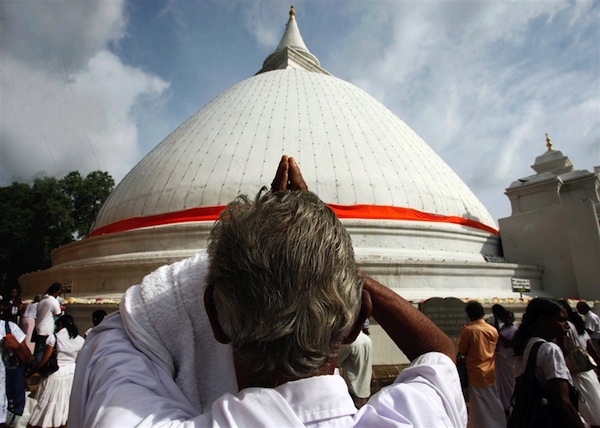Photo courtesy M.A. Pushpa Kumara / EPA, via Photo Blog on MSNBC
Poya must be one of the first Sri Lankan English terms to enter the vocabulary of foreigners when they arrive in Sri Lanka. A poya day is a full moon holiday, a day when devout Buddhists go to the temple and observe sil. To non-Buddhists it is a welcome day off, but (not so welcome for some) a day when meat and alcohol are not available in shops and supermarkets, and are not supposed to be served in restaurants and hotels. Many people are critical of a system which reportedly gives Sri Lanka more public holidays than any other country, and which is seen to favour Buddhism over other religions. But most of us look forward to poya days anyway!
The day before a poya day is called pre-poya. This is a day when evening events and get-togethers are often organised – the equivalent of a Saturday night, the next day being a holiday. It is also a day when liquor stores do brisk business as people stock up for the next day.
The term pre-poya originated in the 1960s during the period when Ceylon adopted a lunar calendar. Instead of the normal Saturday-Sunday weekend, each quarter moon day was a holiday (poya), and the previous day (pre-poya) was a half-day. The days inbetween were labelled P1, P2, P3 etc. Most working weeks consisted of five days (P1 – P5), but since the lunar month is approximately 29.5 days, once every few weeks there would be an extra day (P6). This made it difficult to plan ahead; weekends were out of sync with the rest of the world; and the Roman Catholics were upset that Sunday became a normal working day.
One British diplomat recalled arriving in Colombo at this time and being greeted by a memo which began “Since there are two Thursdays in this week …”. And my correspondent Fazli Sameer recalls that the title of the contemporary Beatles song “8 days a week” became a popular source of humour! If anyone has other memories or anecdotes from this period, I would be interested to hear them.
I had always assumed that this system was introduced by Mrs Bandaranaike during the 1970s, the famous period of isolationist left-wing policies, food shortages, etc. And in researching the subject for this piece I found that several others were under the same impression. But in fact it was adopted by Dudley Senanayake’s UNP government on 6th January 1966, and abandoned by Mrs Bandaranaike after the SLFP election victory in 1970. But the monthly full-moon poya holiday remained.
The introduction of the lunar calendar is remembered as an example of a government pandering to the Sinhala Buddhist nationalist agenda – but, compared to other examples such as SWRD’s ‘Sinhala only’ policy, a relatively harmless one. It is a distant memory now – little seems to have been written on the subject, and many younger people are not even aware that it happened.
###
A-Z of Sri Lankan English is“an all-new, occasional alphabetical dip“into the variety of English spoken in Sri Lanka, published exclusively on“Groundviews. The original A-Z of Sri Lankan English was published in the travelsrilanka magazine, and can be found here.
